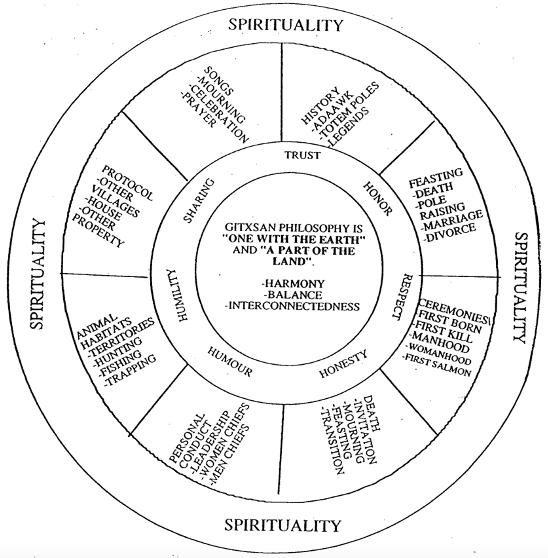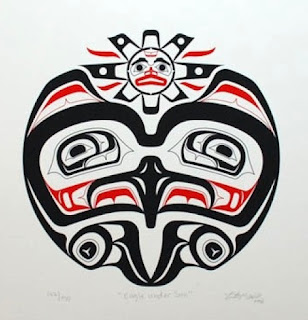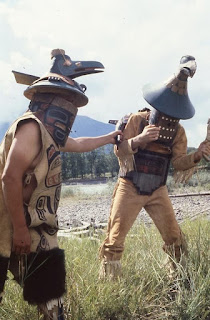Mythologies of the Gitxsan Tribe
Gitxsan (also spelled Gitksan) are an Indigenous people in Canada whose home territory comprises most of the area known as the Skeena Country in English (Git: means "people of" and Xsan: means "the River of Mist"). Gitksan territory encompasses approximately 35,000 km2 (14,000 sq mi) of land, from the basin of the upper Skeena River from about Legate Creek to the Skeena's headwaters and its surrounding tributaries. Part of the Tsimshianic language group, their culture is considered to be part of the civilization of the Indigenous peoples of the Pacific Northwest Coast, although their territory lies in the Interior rather than on the Coast. They were at one time also known as the Interior Tsimshian, a term which also included the Nisga'a, the Gitxsan's neighbours to the north. Their neighbours to the west are the Tsimshian (a.k.a. the Coast Tsimshian) while to the east the Wetʼsuwetʼen, an Athapaskan people, with whom they have a long and deep relationship and shared political and cultural community.
Gitxsan (Gitksan), meaning “People of the River Mist,” live along the Skeena River of northwestern British Columbia in the communities of Hazelton, Kispiox and Glen Vowell (the Eastern Gitxsan bands) and Kitwanga, Kitwankool and Kitsegukla (the Western Gitxsan). In the 2021 census, 5,075 people claimed Gitxsan ancestry. According to the Gitxsan Nation, Gitxsan territory (known as Lax Yip) covers 33,000 km2 of land and water in northwestern British Columbia. This includes the Hazelton area and the Babine, Bulkley, Kispiox and Skeena Rivers. Some Gitxsan territories are shared with or overlapped by neighbouring First Nations, including Carrier Sekani, Gitanyow, Nisga’a, Tahltan, Tsay Keh Dene, Tsimshian and Wet’suwet’en. (See also Indigenous Territory.) In the 2021 census, 5,075 people claimed Gitxsan ancestry. The Gitxsan are matrilineal, meaning that kinship is based on the female line. Gitxsan people are born into one of four kinship lineages (or clans) — Frog, Eagle, Wolf and Fireweed. Gitxsan spouses may not belong to the same clan. Clans have Houses (known as wilp), each with their own chiefs and territories.
“Gitxsan” translates to “people of the river of mist,” referring to the Skeena River. The Nisg̲a’a, Tsimshian, and Gitxsan are neighbors along the Skeena and Nass Rivers. These Nations share many traditions, and their languages are closely related. In Gitxsan society, lineage descends through women. A female Chief typically chooses an heir from among her children or her sister’s children. A male Chief’s heir is chosen from among his sister’s children. The passing down of Chiefly names, as well as property and responsibility, has remained consistent, following the matrilineal system of genealogy. daxgyet | a Chief's authority - In Gitxsanimax̲, the language of the Gitxsan people, this word conveys the strength of the people as well as a Chief's power and authority.
Official website of the Gitxsan First Nation
Websites of individual Gitxsan bands
Tribal organization providing business
services on behalf of the Gitxsan Nation
services on behalf of the Gitxsan Nation
British Columbia museum and interpretive centre
dedicated to demonstrating the richness of
Gitxsan culture and heritage
dedicated to demonstrating the richness of
Gitxsan culture and heritage
Encyclopedia articles on the Gitxsan tribe
Reference list of Gitxsan language materials
Gitxsan links
Information about the Gitksan and other
Northwest Coast First Nations in French and Spanish
Northwest Coast First Nations in French and Spanish
Website about Gitxsan story-telling and oral history
"Nisga'a" and "Gitxsan" are tribal names referring to the traditional territory of the two tribes-- each is the native name of a river that runs through their lands (simplified to "Nass River" and "Skeena River" by English-speaking Canadians.) There have been many spellings of these names over the years, including Nisgaa, Nisga, Nisga-a, Nisgha, Nishga, Niska, Nishka, Nisk'a, Nisqa'a, Gitx̱san, Gitksan, Kitxsan, Kitksan, Ksan, Giklsan, Gitksan, Gitxan, Gityskyan, Gitsken, and Gitksian. The Gitxsan language is sometimes referred to as Gitksanimx or Gitsenimx. Nisga'a band names include Gingolx (or Kincolith), Gitlaxt'aamix (or Aiyansh), Gitwinksihlkw (or Gwinaha), and Laxgalts'ap. Gitxsan band names include Gitwangak (or Kitwanga), Gitanyow, Gitsegukla, Sik-E-Dakh (or Glen Vowell), Gitanmaax (or Hazelton), and Kispiox. Nisga'a-Gitxsan is a Penutian language of the Pacific Northwest Coast, spoken by about 2000 people in the Nisga'a (or Nisgha) and Gitxsan (or Gitksan) tribes of British Columbia. Though the Nisga'a and the Gitxsan are culturally and politically distinct nations, their languages are no more different than American and Australian English and speakers from the two tribes can understand each other with little difficulty. Nisga'a and Gitxsan are consonant-rich, polysynthetic languages with VSO word order.
A dispute over land now has Gitxsan hereditary chiefs threatening to grind trade along that route to a halt. If the British Columbia (B.C.) government doesn’t address the Gitxsan’s concerns by Sept. 16, the group’s leaders say they could begin service disruptions along the railway through their territory, escalating a longstanding feud with the province. Last month, chiefs served what they called “eviction notices” to the national railway, logging companies and sportfishing operators, asking them to halt commercial activities in the aboriginal people’s sleepy territory. Additional police have been dispatched. “Everything is on the table until we get our desired result,” said Beverley Clifton Percival, a negotiator for the Gitxsan who also goes by her First Nations name, Gwaans. The Gitxsan say the province has included land inhabited by their people in treaties proposed for two neighboring Indian bands. Placing new pressure on the Gitxsan’s stalled land negotiations is the natural-gas boom spurred by hydraulic fracturing (fracking). In fact, the Gitxsan Treaty Society, a negotiating body composed of a small group of hereditary chiefs, has broken off discussions on two proposed pipelines that would transport liquefied natural gas, or LNG, through their territory. There’s also intense debate in the province about plans to construct two pipelines for the transport of heavy crude oil from the neighboring province of Alberta to Canada’s west coast. One, Enbridge Northern Gateway, would run near Gitsxan territory. The Gitxsan and First Nations peoples across the country have been emboldened by a June Supreme Court of Canada decision they describe as a “game changer.” In that case, the court sided with the Tsilhqot’in First Nation, a band of roughly 3,000 people residing in British Columbia’s interior, in a dispute over commercial logging. The court ruled that because the Tsilhqot’in were found to hold “aboriginal title” over the territory in question, their permission was required before logging could proceed.





































































Comments
Post a Comment